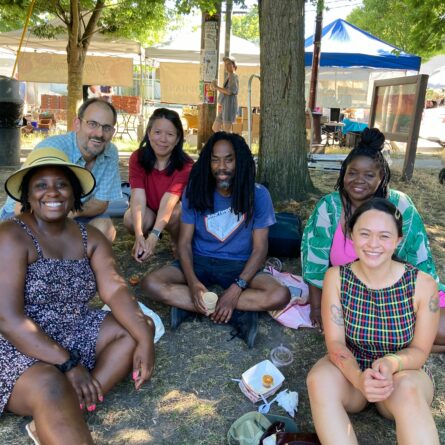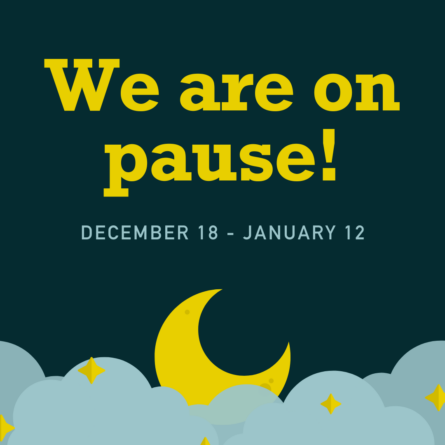
News + Events
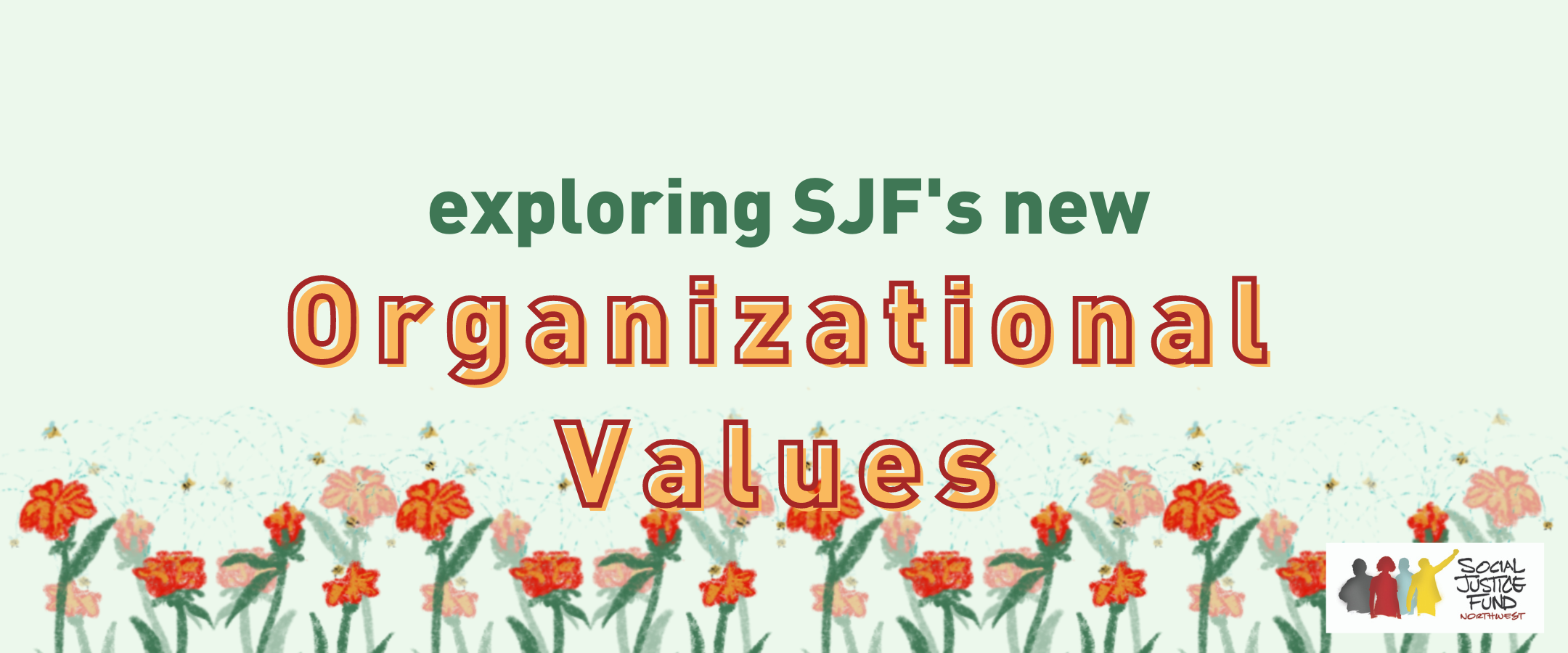
Hello world! This is Alison Cheung, Communications Manager at SJF coming at you with the first in a series of blog posts covering the development and thought process behind Social Justice Fund NW’s updated organizational values, officially launched in November of 2022. We’ll publish one post a month written by myself and SJF Operations Manager Marc Mazique.
The purpose of the series is twofold. First, we wanted a space to let these values resonate — to see how they echo the community around us, how they bounce off of and take their shape from the contours of SJF’s internal and external work. We limited our values statements to short paragraphs to keep them concise and agile, but there’s quite a lot more to say (how we manage to keep these blog post lengths under control has yet to be tested). Second, we know there are and will continue to be slews of harried nonprofit workers and board members tasked with the same undertaking – updating a very significant document, likely without abundant time and resources. The success of our values update process is due in part to what we learned from others. To keep that spirit going, we’ll talk about how we thought through our organization’s needs and the process we used to receive feedback and build a sense of collective ownership of the values without getting (too) bogged down in meetings.
While future blog posts will explore SJF’s relationship to each value individually, today’s post is focused on how we got to them. Let’s get to it!
Background
When I joined SJF in spring of 2020, our organizational values were nearly 20 years old. SJF was in the midst of a significant transformation. Mijo Lee, SJF’s Executive Director from 2016 to 2020 had just transitioned out and our leadership model was in flux. Our focus on uprooting anti-Blackness and centering Black liberation was ongoing, including tending to the relational challenges and conflicts that come with liberatory work. The Program, Grantmaking, and Development teams were all experimenting with new approaches to their structure and/or strategies. Then the pandemic began, crashing in and flooding communities with waves of urgency, uncertainty, danger, and grief. The George Floyd uprisings followed a few months later, to which our grantees, members, and partner organizations showed up in full force. Inside of SJF, staff and board struggled with personal and community trauma, the pressure to respond to grantees and members, taking part in mass actions and mutual aid during a pandemic, a coming recession, and protecting our individual health and safety.
In moments of conflict and urgent action it was evident that we needed values that reflected how SJF had changed and allowed us to be more responsive to the circumstances of our community and organization. However, they also needed to be more than reactive to the political moment, values that could help us fiercely declare and stay true to the work of Black liberation, anti-capitalism, Indigenous sovereignty, and disability justice in the long term. SJF is made up of a staff and board of organizers and community-minded people, all of whom came to the table with strong personal values and various sets of expertise. When our old organizational values fell short and we scrambled for how to approach situations, we tended to get bogged down in how to weave together our perspectives, which sometimes resulted in conflict. We weren’t prepared with a coherent strategy that 1) spoke to SJF’s mission and vision, 2) was responsive to the requirements and limitations of a 501(c)3 organization, 3) boldly served our grantees, and 4) mobilized our members and donors. (It also didn’t help that our last Strategic Plan expired in 2019.) Although we made it out of this period still able to distribute some powerful grants, run several successful Giving Projects, and involve community members, working to do so without a shared foundation with which to ground ourselves collectively was incredibly difficult and draining. It was time for new organizational values.
Process
These were the three guiding considerations that helped us get started:
- There is a difference between values and practices — use a written structure that doesn’t confuse them. A value, in one or two words, describes an intrinsic quality or principle of an outcome (in our case, the outcome is a liberated world). Practices are what that value looks like in action.
- It’s the opposite of helpful for our organizational values to include all our individual, personally held values. Not everything an organization strives to embody needs to be listed in its organizational values. We aimed for five to seven values.
- Our values need to have teeth — they need to be sharp and specific enough to SJF’s work as a funding organization to call us to action and keep us accountable. No mush.
We poured the foundations of our new values in work with Dr. Tashia Harris, a Black liberation consultant we worked with from 2019 to 2020. Dr. Harris interviewed the Black and non-Black staff caucuses, gathering all the values and practices we named as important. He compiled these into a list of values and practices that we eventually drew from when beginning our values revision in earnest in 2021. Throughout 2020, we discussed organizational values 2-3 times as a staff, but lacked a committed body to take on the work. However, these conversations helped construct the frame for our three big considerations.
In early 2021 we formed a working group of three SJF staff members (myself, Marc Mazique, and former staffer Shardé Nabors) and one board member (Em Bookstein) to tackle the values revision. We met biweekly (roughly) from early 2021 through September 2022, when SJF officially adopted our new values. Our process broke down into three phases:
Phase 1: Compilation. We read, discussed, and consolidated SJF’s old values and Dr. Harris’ values and practices list. We also researched the values of the Giving Project Network and other partner organizations.
Phase 2: Drafting. We drafted new values, value definitions, and examples of these values in practice.
Phase 3: Revision. We presented drafts of these value definitions to staff and board to gather feedback and build buy-in/a sense of ownership amongst staff.
Phase 1: Compilation
We started by compiling all of SJF’s old values, the staff values Dr. Harris had gathered, and the Giving Project Network values in one spreadsheet so we could compare and contrast them. We also referenced the values of other funders with missions and models similar to SJF’s to see where they were headed. Our goal was to come up with a list of all the possible values we could pull from these sources that felt true to our work.
At this phase, being able to tell the difference between values and practices was important. For example, an SJF staff member might say, “We should value unlearning harmful language and learning new, generative language from community.” This practice, while worthwhile, isn’t a value in itself. It’s a practice that could draw from several different values. Its spirit might be best summed up by the value of Transformation, a commitment to continual learning and unlearning in the pursuit of liberation (or however you define Transformation in a social justice-y way).
As you might guess, there was a lot of overlap across these different sources. Here are a couple screenshots of our spreadsheet(s):
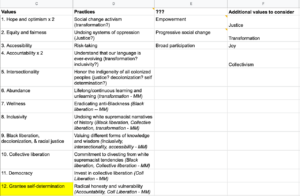
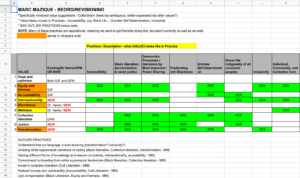
We also identified a few gaps, values we knew SJF’s staff, board, grantees, and members felt strongly about that weren’t represented, as well as gaps in knowledge for values we thought were important but weren’t sure how to enact. These all went into the pot for consideration.
With our goal of five to seven final values in mind, it was time to narrow down the possibilities. We combined values and practices that seemed similar enough under one value umbrella; for example, “democratic process,” “sharing power,” and “broad participation,” were grouped together under what would become “Collective Power.”
By the end of summer 2021, we had narrowed down the list to seven values. It was time to move into drafting.
Phase 2: Drafting
To get started, we adapted the written structure of short values definition plus examples of that value in action in different settings with permission from Surge Reproductive Justice, a badass Black Feminist, grassroots organization based in Seattle. We aimed to keep the definitions under 150 words so they remained sharp, concise, and as free of overly dense social justice lingo as we could manage.
To draft the values definitions, we aimed for short paragraphs of under 150 words. Where our knowledge fell short, we assigned members of our work group to research and share learnings for discussion. We also drafted one or two examples of each value in practice to capture how values are expressed in different situations relevant to our work. We planned to have SJF staff propose other examples in the eventual all-staff review process to both ensure that the values spoke to real-life staff circumstances and build a sense of staff ownership over the values.
More on that last point — we wanted the values to be actually useful. We had all worked with/knew of/been frustrated by nonprofit values that were much more fancy, performative language than they were actionable principles. SJF staff needed to feel comfortable turning to the values as a useful tool in both challenging and exciting times, so it was key that they were written clearly and that we brought in staff for feedback as much as possible without grinding the process to a halt. Feedback that is acted on creates buy-in and a sense of collective ownership.
By winter of 2021, we were ready to begin sharing the first draft with SJF’s staff and board.
Phase 3: Revision
Our colleague and work group partner Shardé Nabors transitioned out of SJF in early 2022. Her incisive thought process and strong project management skills were vital to the values revision process and we missed her quite a bit! With only two full time SJF staff members remaining, we had to balance our capacity and the need to keep the project moving forward. From February through July 2022, we presented the draft definitions to staff for feedback every other week in staff meetings. We recorded these sessions so staff who were not present could hear the discussion and participate on their own time.
For this phase, we created a powerpoint that briefly covered the history of SJF’s values, the point of having organizational values, and the draft values themselves (each one got a slide). After reading the definitions aloud, we used Jamboards to collect staff feedback and generate more examples of values in action. Staff were also provided additional time beyond each specific value conversation to provide additional feedback as they reflected further. Between meetings, we integrated the feedback and examples into the second draft of each value.
These are the questions we used to get feedback via Jamboards. For each question, we gave staff about three minutes to answer.
- “We want to prioritize language that is straightforward and avoids complex jargon. Does the language of this value statement make sense to you?”
- “How is this value relevant to our work?”
- “Any suggested resources / voices to consider or consult with around this definition? Please be specific.”
After integrating staff feedback, we shared the full draft with SJF staff for additional review in July before sharing it with the board. By September, our second draft was officially approved by the board. We launched the values, along with our new 2022-2025 Strategic Plan, in November of 2022!
Outcome & Reflections
I’m so happy with our new values. In my role as Communications Manager, organizational values are a tool I use every day for decision making and writing tasks. I know other teams at SJF will rely on them to plan events, make updates to our political education curriculum, and shape our strategic planning. Yes, our process took a long time, but it gave us the space to untangle our history and understand how organizational values can make or break a collective’s unity in times of struggle and joy.
As a working group, we attribute much of the success of this process to how clear we were with each other and the rest of the organization on our purpose and boundaries. Deciding on a strong written structure and talking through the purpose of values with the staff and board ensured that everyone was on the same page from the beginning. It also gave us the chance to seek unity on our desired outcome with enough room to dream, but enough detail to stay practical. We maintained very strong boundaries to avoid mission creep: we communicated what we were not willing to take on at the outset of our project and continued to check in on these boundaries throughout the process. Additionally, we worked to align our work with the development of SJF’s 2022-2025 Strategic Plan, to ensure both guiding documents laid out a clear vision around resourcing organizations dedicated to the challenging work of liberation.
Other advice that I’d give to other organizations taking on a similarly-scaled values revision would be to make sure that the staff members responsible truly have the capacity (time, intellectual, and emotional — it could be heavy work at times). The values revision work that happened in 2020 was indispensable, but because the project was held by a consultant, passed to staff without a point person to steward it, and then tacked on to an already over-capacity committee, it was difficult to track its progress and keep up the momentum necessary to finish the job. When the working group was assembled in 2021, each of us knew exactly why we were there in the context of our positions. We included the values work in our personal work plans instead of trying to shove it in where it barely fit in typical nonprofit style. Our very well defined project plan and timeline with reasonable goals helped us create a participatory and generative process that still had an endpoint in sight. By presenting during staff meetings, keeping our Jamboards open after meetings, giving and receiving suggestions for resources to learn from, recording our presentations, and offering one-on-one communication (via email and Slack) we offered staff many different options for participation and feedback, which created a sense of trust and buy-in.
And, of course, the work to integrate our new values is not done. Values are just words on a piece of paper until we give them life through our practices, policies, and relational work. This is ongoing at SJF, and something we’ll dive into in future blog posts. Marc and I are still encouraging the rest of the organization to reference the values as they enact parts of our strategic plan, work on the budget, and do personal work-planning, etc. But for now, it feels pretty incredible to bask in the feeling of unity, of one chapter ending, of entering the new year with our roots firmly planted in our new values.
